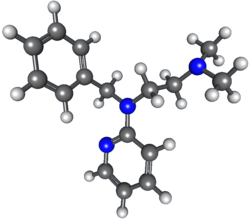This article needs additional citations for verification .(August 2017) |
 | |
 | |
| Clinical data | |
|---|---|
| Trade names | Pyribenzamine |
| AHFS/Drugs.com | Multum Consumer Information |
| MedlinePlus | a601044 |
| Routes of administration | Oral, intravenous |
| ATC code | |
| Legal status | |
| Legal status |
|
| Pharmacokinetic data | |
| Metabolism | Hepatic hydroxylation and glucuronidation |
| Elimination half-life | 4–6 hours [1] |
| Excretion | Renal |
| Identifiers | |
| |
| CAS Number |
|
| PubChem CID | |
| IUPHAR/BPS | |
| DrugBank | |
| ChemSpider | |
| UNII | |
| KEGG | |
| ChEMBL | |
| CompTox Dashboard (EPA) | |
| ECHA InfoCard | 100.001.910 |
| Chemical and physical data | |
| Formula | C16H21N3 |
| Molar mass | 255.365 g·mol−1 |
| 3D model (JSmol) | |
| |
| |
| (verify) | |
Tripelennamine, sold under the brand name Pyribenzamine by Novartis, is a drug that is used as an antipruritic and first-generation antihistamine. It can be used in the treatment of asthma, hay fever, rhinitis, and urticaria, but is now less common as it has been replaced by newer antihistamines. The drug was patented at CIBA, which merged with Geigy into Ciba-Geigy, and eventually becoming Novartis.